
Hackfort Castle is a castle in Vorden, in the Dutch province of Gelderland. The castle is owned by the Vereniging Natuurmonumenten, the Society for Preservation of Nature Monuments.

Hackfort Castle is a castle in Vorden, in the Dutch province of Gelderland. The castle is owned by the Vereniging Natuurmonumenten, the Society for Preservation of Nature Monuments.
Hackfort Castle's earliest known history can be traced back to 1324, when the Lord of Bronckhorst commissioned the building of a castle. In 1392, the lending register of the lords of Bronckhorst mentions "Hacforden", a house with an outer bailey and moat.
The castle was largely destroyed by Spanish troops in 1586 during the Eighty Years' War, and later rebuilt in 1598 by Borchard van Westerholt. The castle was considerably remodeled in 1788 by Borchard Frederic Willem van Westerholt. The new structure had a tighter façade with large windows and cross windows with window shutters at the bottom. The gatehouse was demolished, so that the view of the now symmetrical façade and the landing became unobstructed. The moat was also filled in. The castle is surrounded by forests and meadows and includes the watermill of Hackfort.
In 1324, a Willem van Bronckhorst sold a share in "Hacvorde" to Jacob van der Welle, who subsequently styled himself Van Hackfort. Leenheer remained the Van Bronckhorsten until 1702. In 1581, the castle came into the Van Raesfelt family's possession via their heiress daughter Jacoba van Hackfort. In 1602, through their daughter Margarethe, it was inherited by her cousin Borchard van Westerholt, who had rebuilt the castle before her death. It remained in the possession of the barons Van Westerholt for centuries.
When Borchard Frederik Willem of the Westerholt family died in 1934, he left his five children as heirs. They were all unmarried except for Clara. Clara was evicted in 1935. Her brother and three sisters each retained a quarter share of ownership. In 1964 their 'lady sister' died at The Hague. She left her share in the castle to Natuurmonumenten. In the same year her brother Arend made a will in which he also left his quarter to Natuurmonumenten. Arend and his sisters continued to manage the castle until the last heir died. Arend died on October 8, 1970, his sister Lady Emma on November 28, 1971. The remaining sister, Sannie, was then the sole individual owner of Hackfort. Lady Sannie was the last Westerholt to die on April 14, 1981, with which Hackfort became wholly owned by Natuurmonumenten. [1] [2]
Georg of Limburg, count of Limburg, son of Adolf of Limburg, count of Limburg.

The House of Limburg-Stirum, which adopted its name in the 12th century from the immediate county of Limburg an der Lenne in what is now Germany, is one of the oldest families in Europe. It is the eldest and only surviving branch of the House of Berg, which was among the most powerful dynasties in the region of the lower Rhine during the Middle Ages. Some historians link them to an even older dynasty, the Ezzonen, going back to the 9th century.

De Haar Castle is located in Utrecht, Netherlands. It is the largest castle in The Netherlands.

Richardis of Bavaria was a German noblewoman. She was a daughter of Count Palatine Otto I of Bavaria, who later became the first Wittelsbach Duke of Bavaria, and his wife Agnes of Loon.

Clingendael is the name of a 17th-century manor house and surrounding parkland just outside The Hague, Netherlands, in the municipality of Wassenaar. Since 1982, it houses the Netherlands Institute of International Relations Clingendael.

The Duitse Huis is a complex of buildings in the city of Utrecht, Netherlands, protected as a national monument. The older parts date to a monastery of the Bailiwick of Utrecht of the Teutonic Knights founded in 1348. Originally Catholic, the order became Protestant during the Reformation. A military hospital was added in 1823 after the knights had sold the property. The property was sold back to the Bailiwick of Utrecht and a major renovation started in 1992. Some of the older buildings are again the headquarters of the Bailiwick of Utrecht, now a charity, and hold an important collection of medieval manuscripts, coins and pictures. Other buildings, including the former hospital, have been converted into a five-star hotel, the Grand Hotel Karel V.

The Bailiwick of Utrecht of the Teutonic Order is a chivalric order based in Utrecht, Netherlands. It originated in 1231 as a division of the order of Teutonic Knights.

Haamstede Castle is a castle in the village of Haamstede on the island of Schouwen-Duiveland. It is a rijksmonument.
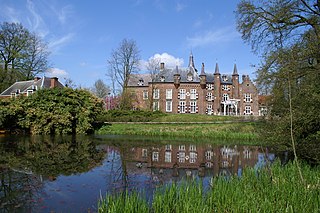
Maurick Castle is a castle in Vught, Netherlands. It had many famous owners and visitors.

Meerwijk Castle is a Tudor Revival Style mansion on the east bank of the Dieze river just north of 's-Hertogenbosch. It was preceded by Meerwijk Manor, built on the same location.

Waardenburg Castle, sometimes also called Weerdenburg, is a medieval castle located in Waardenburg in the municipality of West Betuwe, in the Dutch province of Gelderland.

Tongelaar Castle is located between Mill and Gassel in North-Brabant, Netherlands.

Geldrop Castle is a castle with park near the center of Geldrop, North-Brabant, the Netherlands. It is on the edge of the valley of the Kleine Dommel.
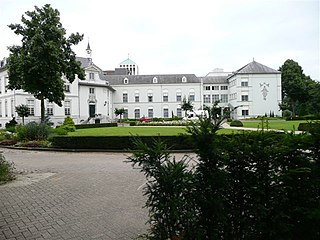
Boxmeer Castle is an originally 13th century castle in Boxmeer, North-Brabant, Netherlands. It is situated on a former island in the Meuse.
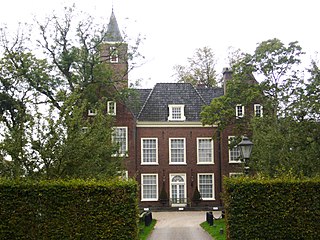
Binckhorst Castle is a 16th and 17th century manor built on top of a demolished medieval castle.
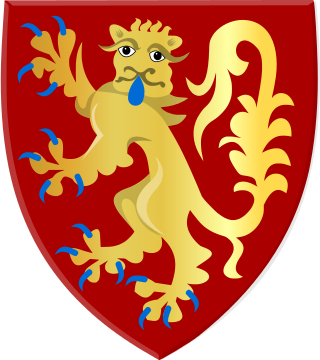
Machteld van Voorne was Lady of Voorne, Monschau and Valkenburg, and burgrave of Zeeland. During the Hook and Cod wars she was an important ally of Count William V of Holland.

Baarland Castle is a former castle in Baarland, Netherlands.
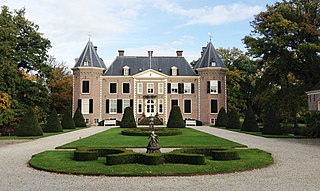
Nijenhuis is a castle and an estate near Diepenheim in the municipality Hof van Twente, Netherlands.

Coldenhove Castle was a castle in Eerbeek, the Netherlands. Due to its excellent location in the Veluwe, the castle used as hunting lodge by the dukes of Guelders and the princes of Orange. Nothing remains anymore of the castle or its gardens.